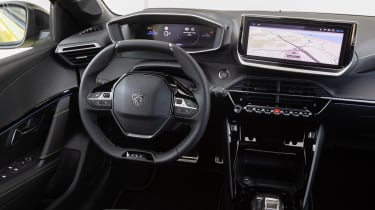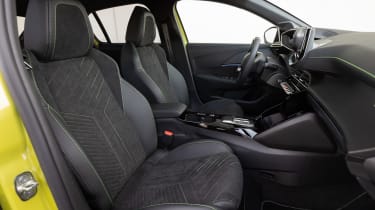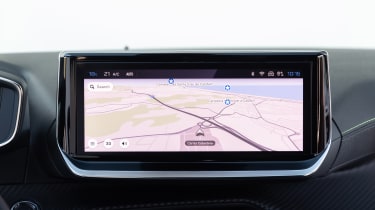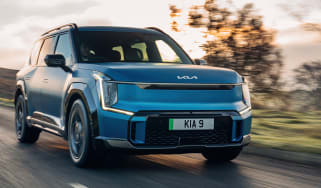Peugeot E-208: interior, dashboard & infotainment
The Peugeot E-208’s interior is a classic example of form over function; make sure to try its peculiar driving position before you commit to buying one
The Peugeot E-208’s good looks continue inside thanks to the brand’s i-Cockpit dashboard layout which feels like something out of a concept car. Design has obviously taken precedent over ergonomics in some areas, but material quality is pretty strong across the board – as it should be, given the E-208’s pretty lofty starting price.
Peugeot E-208 dashboard
The Peugeot E-208’s dashboard feels undeniably special in the way everything is angled towards the driver. While base cars get a traditional analogue set of dials, step up to the mid-spec Allure and you’re greeted by a sleek-looking 10-inch driver’s display behind the steering wheel. This is relatively configurable – even if the graphics are rather dark and dingy – and it even offers a neat 3D effect in top-spec GT models.
That’s all well and good, but unfortunately a couple of glaring oversights spoil what is otherwise an almost class-leading cabin; for starters, there’s the driving position. Due to how the small squared-off steering wheel is mounted below the dials, it means you have to position it uncomfortably low to be able to even see what speed you’re going at. The result of this is the wheel will bash into your knee whenever you turn the wheel; it may not be a problem for all body types, but we insist that you try before you buy.
The other issue we have is that the climate controls constantly take up a large portion of each side of the infotainment screen; their presence almost negates the benefit of having a larger central display and we wish that Peugeot had instead mounted them below the screen in a set of physical toggles or dials like in the Vauxhall Corsa Electric.
Equipment, options & accessories
Peugeot changes the E-208’s trim line-up almost as often as the UK does its prime minister, so all of this is subject to change; as of November 2023 there are four specifications to choose from: Active, Allure, GT and the limited-run E-Style.
Starting from just over £32,000, the Peugeot E-208 Active gets a decent, if not exceptional, level of standard equipment. The base level of kit includes LED headlights, 16-inch steel wheels, fabric upholstery, climate control, a 10-inch touchscreen with wireless Apple CarPlay and Android Auto, a heat pump and rear parking sensors.
The step up one rung and the mid-spec Allure model will set you back around £1,500 but this nets you some pretty desirable extras including a fully-digital instrument cluster (base cars get old-school analogue dials), 16-inch diamond-cut alloys, upgraded upholstery and front parking sensors.
Sitting at the top of the range is the GT model which, costing from over £36,000, is pretty expensive for an electric supermini; in fact, it’s almost £10,000 pricier than a base MG4. It does come pretty highly specified, though, with things like leatherette sports seats, a wireless smartphone charger, 3D dials, ambient lighting and a reversing camera. GT cars also get added gloss black exterior accents and larger 17-inch wheels, while heated seats can be added for an extra £500.

Finally there’s the E-Style which comes with the old 50kWh battery pack, meaning it has a reduced range. It also costs about £200 more than the entry-level Active car and gets the old seven-inch touchscreen instead of the newer 10-inch unit. So, why should you care? Well, it does get a handful of desirable upgrades including the 16-inch wheels, front parking sensors and posher upholstery found in the mid-spec Allure, as well as tinted rear windows. You’d better act fast if you want one of these, though, as the E-Style is only available until January 2024.
Infotainment, apps & sat nav
All versions of the Peugeot E-208 – bar the limited-run E-Style – now get a 10-inch touchscreen as standard. This is much more vibrant and responsive to your inputs than the old system and comes with wireless Apple CarPlay and Android Auto functionality. If you’d rather not use your phone, you can spec the car to have TomTom sat-nav built-in, but we don’t see much point given how Google, Waze and even Apple Maps are usually much better.
One thing we would say is that while Peugeot has revised the layout of its infotainment system, it’s not quite as intuitive as the one you find in the equivalent electric Kia or Hyundai; we’ve already mentioned the climate controls taking up a large portion of the screen, but we also think there are a few too many sub menus, making it fiddly to operate whilst driving.






